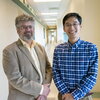Analytical Chemistry
Analytical Chemistry at Illinois is among the strongest programs in the country and has been so for over three-quarters of a century. This long, rich tradition is perpetually refreshed as faculty and students complete work in maturing areas and then open new vistas. Currently, there is great excitement in bioanalytical chemistry and non-biological surface catalysis. This impact focus contrasts with the stereotypical view that analytical chemistry is about instrument and method development. In fact, many novel instruments and techniques are developed in the course of research. There are so many instruments and techniques one might pursue that the wise selection of these developments is based on cutting-edge problems in biomedicine, catalysis, energy production and conservation, ecology, and other real-world problem areas. Among the developments at Illinois in recent years has been:
- Nano-resolved electroanalytical platform development for studying neurotransmission at single and bio-nanostructures
- Detection of peptides in single nerve cells by MALDI mass spectrometry
- NMR of nanoliter samples
- Fabrication of molecular gating devices for switching analytes as they transit nanofabricated microfluidic switchyards.
- Characterization of the fundamental corrosion processes active in aluminum and ferric alloys.
- Development of nanostructured catalysts for fuel cells giving world-record current densities and relative freedom from poisening.
- Large-scale sequencing of proteins starting with intact molecules with molecular weights over 50,000.
All this is accomplished in a friendly, collegial atmosphere where students may have multiple research advisors, and may collaborate with other students and faculty across campus, across the nation, and around the world. Because of the quality and size of support facilities, the question rarely is "do we have the ability to push back scientific frontiers" but rather is "with whom should we collaborate to most rapidly and easily push back the frontiers?" Facilities supporting the development and exploitation of modern measurement technologies include:
- School of Chemical Sciences machine, glass, and electronics shops.
- Mass spectrometers, both in School facilities and individual research groups.
- Magnetic resonance spectrometers in the VOICE NMR lab, Illinois EPR Research Center, and individual research groups.
- Surface science equipment at the Seitz Materials Research Center, individual research groups, and in the ACES and Veterinary Medicine colleges.
- Laser spectrometry equipment in research groups and central facilities allowing nearly any optical analytical technique to be carried out routinely.
- DNA sequencing, protein sequencing, and biomolecule synthesis through the Biotechnology Center and Institute for Genomic Biology.
- Collaboration with biologists, computer scientists, psychologists, and engineers through the Beckman Institute and the National Center for Supercomputing Applications.
- One of the largest, most complete library collections in North America. Illinois has the largest chemistry collection of ANY university in the world that has a graduate program in Analytical Chemistry
Please browse through our research descriptions and feel free to contact any of us to discuss our research interests, programs, and interdisciplinary activities. You'll find that Illinois has a unique blend of scholarly excellence and friendly, collaborative atmosphere.
Related News
- Kristin Martin and Jason Wu are among the thousands of students nationwide to be awarded the prestigious National Science Foundation fellowships in the highly competitive program.
- The Interim Director of the Beckman Institute for Advanced Science and Technology, chemistry Prof. Catherine Murphy was recently appointed to a National Academies of Sciences, Engineering, and...
- Beckman researchers led by bioengineering Prof. Fan Lam, chemistry Prof. Jonathan Sweedler, and Beckman Institute Graduate Fellow Richard Xie used a biochemical imaging framework integrated with deep...



